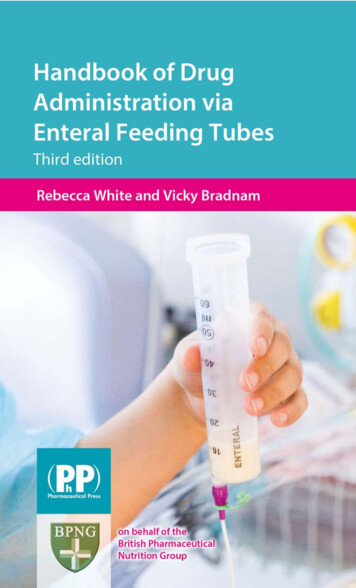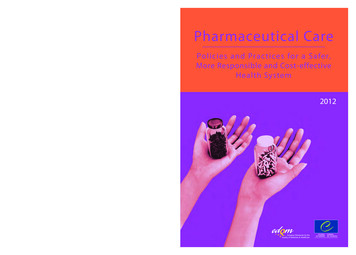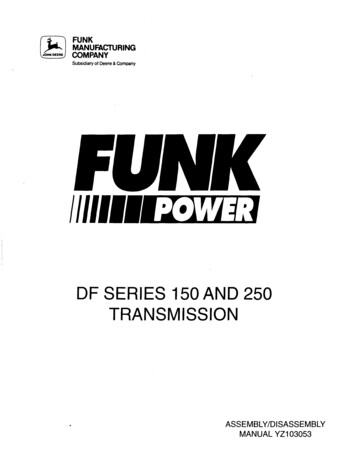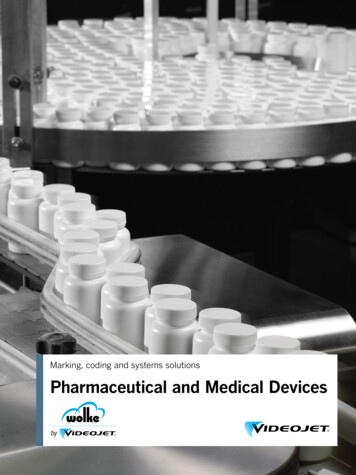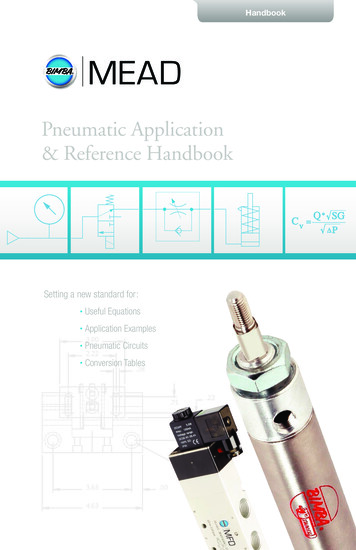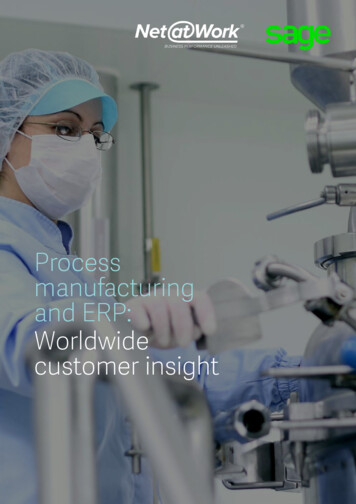
Transcription
PHARMACEUTICALMANUFACTURINGHANDBOOKRegulations andQualitySHAYNE COX GAD, PH.D., D.A.B.T.Gad Consulting ServicesCary, North CarolinaA JOHN WILEY & SONS, INC., PUBLICATION
PHARMACEUTICALMANUFACTURINGHANDBOOKRegulations andQuality
PHARMACEUTICALMANUFACTURINGHANDBOOKRegulations andQualitySHAYNE COX GAD, PH.D., D.A.B.T.Gad Consulting ServicesCary, North CarolinaA JOHN WILEY & SONS, INC., PUBLICATION
Copyright 2008 by John Wiley & Sons, Inc. All rights reservedPublished by John Wiley & Sons, Inc., Hoboken, New JerseyPublished simultaneously in CanadaNo part of this publication may be reproduced, stored in a retrieval system, or transmitted in any formor by any means, electronic, mechanical, photocopying, recording, scanning, or otherwise, except aspermitted under Section 107 or 108 of the 1976 United States Copyright Act, without either the priorwritten permission of the Publisher, or authorization through payment of the appropriate per-copy feeto the Copyright Clearance Center, Inc., 222 Rosewood Drive, Danvers, MA 01923, (978) 750-8400, fax(978) 750-4470, or on the web at www.copyright.com. Requests to the Publisher for permission shouldbe addressed to the Permissions Department, John Wiley & Sons, Inc., 111 River Street, Hoboken,NJ 07030, (201) 748-6011, fax (201) 748-6008, or online at http://www.wiley.com/go/permission.Limit of Liability/Disclaimer of Warranty: While the publisher and author have used their best effortsin preparing this book, they make no representations or warranties with respect to the accuracyor completeness of contents of this book and specifically disclaim any implied warranties ofmerchantability or fitness for a particular purpose. No warranty may be created or extended by salesrepresentatives or written sales materials. The advice and strategies contained herein may not besuitable for your situation. You should consult with a professional where appropriate. Neither thepublisher nor author shall be liable for any loss of profit or any other commercial damages, includingbut not limited to special, incidental, consequential, or other damages.For general information on our other products and services or for technical support, please contactour Customer Care Department within the United States at (800) 762-2974, outside the United Statesat (317) 572-3993 or fax (317) 572-4002.Wiley also publishes its books in a variety of electronic formats. Some content that appears in printmay not be available in electronic formats. For more information about Wiley products, visit our website at www.wiley.com.Library of Congress Cataloging-in-Publication Data is available.ISBN: 978-0-470-25959-7Printed in the United States of America10 9 8 7 6 5 4 3 2 1
CONTRIBUTORSEmmanuel O. Akala, Department of Pharmaceutical Sciences, School of Pharmacy,Howard University, Washington, DC, Effect of Packaging on Stability of Drugsand Drug ProductsGiuseppe Alibrandi, Università di Messina, Messina, Italy, Alternative AcceleratedMethods for Studying Drug Stability: Variable-Parameter KineticsEdward R. Arling, Amgen, Inc., Thousand Oaks, California, Creating and Managinga Quality Management SystemChristina Bartmann, Medical University of Graz, Graz, Austria, GMP-CompliantPropagation of Human Multipotent Mesenchymal Stromal CellsJames M. Barquest, Ground Zero Pharmaceuticals, Inc., Irvine, California, Role ofQuality Systems and Audits in Pharmaceutical Manufacturing EnvironmentDenise Bohrer, Chemistry Department, Universidade Federal de Santa Maria,Santa Maria, Brazil, Origin of ContaminationChung Chow Chan, Azopharma Contract Pharmaceutical Services, Miramar,Florida, Analytical Method Validation: Principles and PracticesRobert P. Cogdill, Duquense University Center for Pharmaceutical Technology,Pittsburgh, Pennsylvania, Case for Process Analytical Technology: Regulatory andIndustrial PerspectivesMarc De Loose, Institute for Agricultural and Fisheries Research (ILVO), ScientificInstitute for the Flemish Community, Merelbeke, Belgium, Analytical MethodValidation and Quality AssuranceKatherine V. Domenick, Training and Communications Group, Inc., Berwyn,Pennsylvania, Personnel Training in Pharmaceutical Manufacturingv
viCONTRIBUTORSMichelle E. Dowling, Amgen, Inc., Thousand Oaks, California, Creating and Managing a Quality Management SystemL. Antonio Estévez, University of Puerto Rico, Mayagüez, Puerto Rico, DrugStabilityD.C. Ferreira, Faculty of Pharmacy, University of Porto, Porto, Portugal, Pharmaceutical Manufacturing Validation PrinciplesAlvin Fox, University of South Carolina, Columbia, South Carolina, Quantitation of Markers for Gram-Negative and Gram-Positive Endotoxins in WorkEnvironment and as Contaminants in Pharmaceutical Products Using GasChromatography–Tandem Mass SpectrometryPaul A. Frankel, Amgen, Inc., Thousand Oaks, California, Creating and Managinga Quality Management SystemDavid A. Gallup, Training and Communications Group, Inc., Berwyn, Pennsylvania,Personnel Training in Pharmaceutical ManufacturingSrinivas Ganta, University of Auckland, Auckland, New Zealand, Scale-Up andPostapproval Changes (SUPAC) RegulationsSanjay Garg, University of Auckland, Auckland, New Zealand, Scale-Up and Postapproval Changes (SUPAC) RegulationsMarge Gillis, Training and Communications Group, Inc., Berwyn, Pennsylvania,Personnel Training in Pharmaceutical ManufacturingJames R. Harris, James Harris Associates, Inc., Durham, North Carolina, GoodManufacturing Practices (GMP) and Related FDA GuidelinesAshley John, New Jersey Institute of Technology, Newark, New Jersey, Analyticaland Computational Methods and Examples for Designing and Controlling TotalQuality Management Pharmaceutical Manufacturing SystemsHerman Lam, Wild Crane Horizon, Inc., Scarborough, Ontario, Canada, Validationof Laboratory InstrumentsMarko Närhi, Helsinki University of Technology, Helsinki, Finland, National GMPRegulations and Codes and International GMP Guides and Guidelines: Correspondences and DifferencesKenneth J. Nolan, Nolan & Auerbach, Fort Lauderdale, Florida, Enforcement ofGood Manufacturing PracticesKatrina Nordström, Helsinki University of Technology, Helsinki, Finland, NationalGMP Regulations and Codes and International GMP Guides and Guidelines:Correspondences and DifferencesNazario D. Ramirez-Beltran, University of Puerto Rico, Mayagüez, Puerto Rico,Drug StabilityGregory N. Ranky, Public Research University of New Jersey, Newark, New Jersey,Analytical and Computational Methods and Examples for Designing and Controlling Total Quality Management Pharmaceutical Manufacturing Systems
CONTRIBUTORSviiPaul G. Ranky, New Jersey Institute of Technology, Newark, New Jersey, Analyticaland Computational Methods and Examples for Designing and Controlling TotalQuality Management Pharmaceutical Manufacturing SystemsRichard G. Ranky, New Jersey Institute of Technology, Newark, New Jersey, Analytical and Computational Methods and Examples for Designing and ControllingTotal Quality Management Pharmaceutical Manufacturing SystemsAndreas Reinisch, Medical University of Graz, Graz, Austria, GMP-CompliantPropagation of Human Multipotent Mesenchymal Stromal CellsHarry Rodriguez, Cordis LLC, a Johnson & Johnson Company, San Juan, PuertoRico, Drug StabilityYves Roggo, F. Hoffmann-La Roche, Ltd., Basel, Switzerland, Process AnalyticalTechnology; Chemical Imaging and Chemometrics: Useful Tools for Process Analytical TechnologyEva Rohde, Medical University of Graz, Graz, Austria, GMP-Compliant Propagation of Human Multipotent Mesenchymal Stromal CellsB. Saramento, Faculty of Pharmacy, University of Porto, Porto, Portugal, Pharmaceutical Manufacturing Validation PrinciplesKatharina Schallmoser, Medical University of Graz, Graz, Austria, GMPCompliant Propagation of Human Multipotent Mesenchymal Stromal CellsPuneet Sharma, University of Auckland, Auckland, New Zealand, Scale-Up andPostapproval Changes (SUPAC) RegulationsEvan B. Siegel, Ground Zero Pharmaceuticals, Inc., Irvine, California, Role ofQuality Systems and Audits in Pharmaceutical Manufacturing EnvironmentE.B. Souto, Free University of Berlin, Berlin, Germany; Faculty of Pharmacy,University of Porto, Porto, Portugal, Pharmaceutical Manufacturing ValidationPrinciplesDirk Strunk, Medical University of Graz, Graz, Austria, GMP-Compliant Propagation of Human Multipotent Mesenchymal Stromal CellsMichel Ulmschneider, F. Hoffman-La Roche, Ltd., Basel, Switzerland, Process Analytical Technology; Chemical Imaging and Chemometrics: Useful Tools for ProcessAnalytical TechnologyIsabel Taverniers, Institute for Agricultural and Fisheries Research (ILVO), Scientific Institute for the Flemish Community, Merelbeke, Belgium, Analytical MethodValidation and Quality AssuranceErik Van Bockstaele, Institute for Agricultural and Fisheries Research (ILVO),Scientific Institute for the Flemish Community, Merelbeke, Belgium, AnalyticalMethod Validation and Quality AssuranceT. Vasconcelos, Laboratory of Pharmaceutical Development, BIAL, Mamede doCoronado, Portugal; Faculty of Pharmacy, University of Porto, Porto, Portugal,Pharmaceutical Manufacturing Validation Principles
viiiCONTRIBUTORSRanga Velagaleti, BASF Corporation, Florham Park, New Jersey, Microbiology ofNonsterile Pharmaceutical Manufacturing; Stability and Shelf Life of Pharmaceutical ProductsAndrew A. Webster, McWhorter School of Pharmacy, Birmingham, Alabama, Pharmaceutical Product StabilityJyh-hone Wang, University of Rhode Island, Kingston, Rhode Island, QualityProcess Improvement
CONTENTSPREFACESECTION 11.1xiiiGOOD MANUFACTURING PRACTICES (GMP) ANDOTHER FDA GUIDELINESGood Manufacturing Practices (GMPs) and Related FDAGuidelines13James R. Harris1.2Enforcement of Current Good Manufacturing Practices45Kenneth J. Nolan1.3Scale-Up and Postapproval Changes (SUPAC) Regulations67Puneet Sharma, Srinivas Ganta, and Sanjay Garg1.4GMP-Compliant Propagation of Human Multipotent MesenchymalStromal Cells97Eva Rohde, Katharina Schallmoser, Christina Bartmann, Andreas Reinisch,and Dirk StrunkSECTION 22.1INTERNATIONAL REGULATIONS OF GOODMANUFACTURING PRACTICESNational GMP Regulations and Codes and International GMPGuides and Guildelines: Correspondences and Differences117119Marko Närhi and Katrina Nordströmix
xCONTENTSSECTION 33.1QUALITYAnalytical and Computational Methods and Examples for Designingand Controlling Total Quality Management PharmaceuticalManufacturing Systems163165Paul G. Ranky, Gregory N. Ranky, Richard G. Ranky, and Ashley John3.2Role of Quality Systems and Audits in PhatmaceuticalManufacturing Environment201Evan B. Siegel and James M. Barquest3.3Creating and Managing a Quality Management System239Edward R. Arling, Michelle E. Dowling, and Paul A. Frankel3.4Quality Process Improvement287Jyh-hone WangSECTION 44.1PROCESS ANALYTICAL TECHNOLOGY (PAT)Case for Process Analytical Technology: Regulatory and IndustrialPerspectives311313Robert P. Cogdill4.2Process Analytical Technology353Michel Ulmschneider and Yves Roggo4.3Chemical Imaging and Chemometrics: Useful Tools for ProcessAnalytical Technology411Yves Roggo and Michel UlmschneiderSECTION 55.1PERSONNELPersonnel Training in Pharmaceutical Manufacturing433435David A. Gallup, Katherine V. Domenick, and Marge GillisSECTION 66.1CONTAMINATION AND CONTAMINATIONCONTROLOrigin of Contamination455457Denise Bohrer6.2Quantitation of Markers for Gram-Negative and Gram-PositiveEndotoxins in Work Environment and as Contaminants inPharmaceutical Products Using Gas Chromatography–TandemMass Spectrometry533Alvin Fox6.3Microbiology of Nonsterile Pharmaceutical ManufacturingRanga Velagaleti543
CONTENTSSECTION 77.1DRUG STABILITYStability and Shelf Life of Pharmaceutical Productsxi557559Ranga Velagaleti7.2Drug Stability583Nazario D. Ramirez-Beltran, Harry Rodriguez, and L. Antonio Estévez7.3Effect of Packaging on Stability of Drugs and Drug Products641Emmanuel O. Akala7.4Pharmaceutical Product Stability687Andrew A. Webster7.5Alternative Accelerated Methods for Studying Drug Stability:Variable-Parameter Kinetics701Giuseppe AlibrandiSECTION 8 VALIDATION7258.1727Analytical Method Validation: Principles and PracticesChung Chow Chan8.2Analytical Method Validation and Quality Assurance743Isabel Taverniers, Erik Van Bockstaele, and Marc De Loose8.3Validation of Laboratory Instruments791Herman Lam8.4Pharmaceutical Manufacturing Validation Principles811E. B. Souto T. Vasconcelos D. C. Ferreira, and B. SarmentoINDEX839
PREFACEThis Handbook of Manufacturing: Regulations and Quality focuses on all regulatoryaspects and requirements that govern how drugs are produced for evaluation (and,later, sale to and use in) humans. The coverage ranges from what the issues are atthe early stages (when the amounts are small and the materials of limited sophistication) up to until the issue is reproducibly and continuously making large volumesof a highly sophisticated manufactured product. These 25 chapters cover the fullrange from preformulation of a product (the early exploratory work that allows usto understand how to formulate and deliver the drug) to identification of sourcesof contamination and assessment of stability.The Handbook of Manufacturing: Regulations and Quality seeks to cover theentire range of available approaches to satisfying the wide range of regulatoryrequirements for making a highly defined product that constitutes a successful newdrug and how to do so in as effective and as efficient a manner as possible.Thanks to the persistent efforts of Michael Leventhal, these 25 chapters, whichare written by leading practitioners in each of these areas, provide coverage of theprimary approaches to the fundamental regulatory challenges that must be overcome to manufacture successfully a deliverable and stable new drug.xiii
SECTION 1GOOD MANUFACTURING PRACTICES(GMP) AND OTHER FDA GUIDELINES
1.1GOOD MANUFACTURINGPRACTICES (GMP) AND RELATEDFDA GUIDELINESJames R. HarrisJames Harris Associates, Inc., Durham, North 71.1.81.1.9FDA Regulations: Real and Imagined21 CFR 210 and 211: Current Good Manufacturing Practice for FinishedPharmaceuticalsGuidance for Industry: Quality Systems Approach to Pharmaceutical Current GoodManufacturing Practice Regulations1.1.3.1 CGMPS and the Concepts of Modern Quality Systems1.1.3.2 Quality Systems ModelGuidance for Industry: PAT—Framework for Innovative Pharmaceutical Development, Manufacturing, and Quality Assurance1.1.4.1 PAT FrameworkGuidance for Industry: Part 11. Electronic Records; Electronic Signatures—Scope andApplicationGuidance for Industry and FDA: Current Good Manufacturing Practice for Combination ProductsGuidance for Industry: Powder Blends and Finished Dosage Units—Stratified InProcess Dosage Unit Sampling and Assessment1.1.7.1 Validation of Batch Powder Mix Homogeneity1.1.7.2 Verification of Manufacturing CriteriaGuidance for Industry: Immediate-Release Solid Oral Dosage Forms Scale-Up andPostapproval Changes (SUPAC)—Chemistry, Manufacturing and Controls, In VitroDissolution Testing, and In Vivo Bioequivalence DocumentationOther GMP-Related Guidance DocumentsPharmaceutical Manufacturing Handbook: Regulations and Quality, edited by Shayne Cox GadCopyright 2008 John Wiley & Sons, Inc.3
41.1.1GOOD MANUFACTURING PRACTICES & RELATED FDA GUIDELINESFDA REGULATIONS: REAL AND IMAGINEDA regulation is a law. In the United States, all federal laws have been arranged orcodified in a manner that makes it easier to find a specific law. The Code of FederalRegulations (CFR) is a compilation of all federal laws published in the FederalRegister by the executive departments and agencies of the federal government. Thiscode is divided into 50 titles which represent broad areas of federal regulation. Eachtitle is further divided into chapters. The chapters are then subdivided into partscovering specific regulatory areas. Changes and additions are first published in theFederal Register. Both the coded law and the Federal Register must be used to determine the latest version of any rule. All food- and drug-related laws are containedin Title 21 of the CFR. Each title of the CFR is updated annually. Title 21 is updatedas of April 1 of each year.Because virtually all of the drug regulations are written to state what should bedone but do not tell how to do it, the Food and Drug Administration (FDA) alsopublishes guidance documents. These documents are intended to provide preciselywhat the name implies—guidance. In this context, guidance documents are not lawand do not bind the FDA or the public. Manufacturers are not required to use thetechniques or approaches appearing in the guidance document. In fact, FDA representatives have repeatedly stated that the regulations were not written to suggesthow something should be done in order to encourage innovation. While followingthe recommendations contained in the guidance documents will probably assureacceptance (agency philosophy and interpretation may have changed since the guidance document was published), other approaches are encouraged. No matter howthey choose to proceed, manufacturers should be prepared to show that theirmethods achieve the desired results.A method used by the FDA to “float” new ideas is to discuss them at industrygatherings such as FDA-sponsored seminars or meetings of industry groups such asthe Pharmaceutical Manufacturers Association (PMA), the Parenteral Drug Association (PDA), and the International Society of Pharmaceutical Engineering (ISPE).Again, it must be remembered that while these comments reflect current FDAthinking, they are simply thoughts and recommendations. They are not law.Several industry groups also publish comments, guidelines, and so on, that putforth current thinking of the group writing the document. These publications areinteresting and often bring out valuable information. However, it is important toremember that these publications are not regulations or even official guidance documents. If a firm chooses to follow the recommendations of such documents, they areprobably following good advice. However, since the advice comes from a nonofficialsource, firms should still be prepared to defend their actions with good scientificreasoning.1.1.2 21 CFR 210 AND 211: CURRENT GOOD MANUFACTURINGPRACTICE FOR FINISHED PHARMACEUTICALSParts 210 and 211 of CFR Title 21 are the laws defining good manufacturing practices for finished pharmaceutical products. All manufacturers must follow theseregulations in order to market their products in the United States. When a firm filesan application to market a product in the United States through a New Drug Application (NDA), abbreviated NDA, (ANDA), Biological License Application (BLA),
CURRENT GOOD MANUFACTURING PRACTICE5or other product application, one of the last steps in approving the application is apreapproval inspection of the manufacturing facility. A major purpose of this inspection is to assure adherence to the GMP regulations. Preapproval inspections are apart of every application approval. Thus, if a firm has 10 applications pending, itshould expect 10 inspections. The fact that the manufacturing facility has alreadybeen inspected will not alter the need for another inspection.The FDA also has the right to visit and inspect any manufacturing facility thatproduces a product or products sold in the United States. Such inspections are unannounced. A manufacturer must admit an inspector when he or she appears at thatfacility and must do so without undue delay.GMP requirements for manufacturers of pharmaceutical dosage forms are discussed below. This information should not be considered to be an exact statementof the law. We have attempted to show intent and, occasionally, add some commentsthat will clarify how that particular regulation is interpreted. For precise wording ofa regulation, refer to the CFR and then check the Federal Register to determine ifthere have been any changes since the last update.General Provisions1. This section pertains to the manufacture of drug products for humans oranimals.2. These requirements will not be enforced for over-the-counter (OTC) drug products if the products and all their ingredients are ordinarily marketed and considered as human foods and which products may also fall within the legal definitionof drugs by virtue of their intended use.Organization and Personnel1. Responsibilities of quality control unit(a) A quality control unit must be a part of the facility organization.(b) This unit must be given responsibility and authority to approve or reject allcomponents, drug product containers, closures, process materials, packagingmaterial, labeling, and drug products, and the authority to review productionrecords.(c) Adequate laboratory facilities for testing and approval or rejection of theabove listed materials must be available.(d) The quality control unit is responsible for approving or rejecting all procedures or specifications that impact on the identity, strength, quality, and purityof the drug product.(e) Responsibilities and procedures applicable to the quality control unit mustbe written and these procedures must be followed.2. Personnel qualifications(a) Every person involved in the manufacture, processing, packing, or holding ofa drug product must have education, training, and experience that enablethat individual to perform their duties. Employees must be trained in theparticular operations that they perform and in Current GMPs (CGMPs). TheGMP training must be conducted by qualified individuals and with sufficientfrequency to assure that workers remain familiar with the requirementsapplicable to them.
6GOOD MANUFACTURING PRACTICES & RELATED FDA GUIDELINES(b) Persons responsible for supervision must have the education, training, andexperience to perform their assigned functions in such a manner as to assurethat the drug product has the safety, identity, strength, quality, and potencythat it is represented to possess.(c) There must be an adequate number of qualified personnel to perform theneeded tasks.3. Personnel responsibilities(a) Personnel shall wear clean clothing appropriate for the duties they perform.Protective apparel must be worn as necessary.(b) Personnel shall practice good sanitation and health habits.(c) Only personnel authorized by supervisory personnel shall enter those areasdesignated as limited-access areas.(d) Any worker considered to have an apparent illness or open lesions that mayadversely affect safety or quality of drug products shall be excluded fromdirect contact with product, components, or containers.4. Consultants that advise on the manufacture, processing, packing, or holding ofdrug products must have sufficient education, training, and experience to adviseon the subject for which they are retained. The manufacturer must maintainrecords of name, address, and qualifications of any consultants and the type ofservice they provide.Buildings and Facilities1. Design and construction features(a) Buildings should be of suitable size, construction location to facilitate cleaning, maintenance, and proper operations.(b) Space should be adequate for the orderly placement of equipment and materials to prevent mix-ups between different components, drug product containers and closures, labeling, in-process materials, or drug products and toprevent contamination.(c) The movement of components and product through the building must bedesigned to prevent contamination.(d) Operations should be performed within specifically defined areas havingadequate control systems to prevent contamination or mix-ups during eachof the following procedures:(i) Receipt, identification, storage, and withholding from use of components, drug product containers, closures, and labeling, pending theappropriate sampling, testing, and release for manufacturing orpackaging.(ii) Holding rejected materials listed in (a) above.(iii) Storage of released components, drug product containers, closures, andlabeling.(iv) Storage of in-process materials.(v) Manufacturing and processing operations.(vi) Packaging and labeling operations.(vii) Quarantine storage before release of drug products.(viii) Storage of drug products after release.(ix) Control and laboratory operations.
CURRENT GOOD MANUFACTURING PRACTICE2.3.4.5.6.7.7(x) Aseptic processing, which includes:(1) Floors, walls, and ceilings of smooth, hard surfaces that are easilycleanable.(2) Temperature and humidity controls.(3) An air supply filtered through High-Efficiency Particulate Air(HEPA) filters under positive pressure regardless of whether flowis laminar or nonlaminar.(4) A system for monitoring environmental conditions.(5) A system for cleaning and disinfecting the room and equipment toproduce aseptic conditions.(6) A system for maintaining any equipment used to control the asepticconditions.(e) Operations relating to the manufacture, processing, and packing of penicillinmust be performed in facilities separate from those used for other drugproducts for humans. Note: For all purposes of these GMP regulations, theFDA considers cephalosporins to be penicillin.Adequate lighting should be provided in all areas.Heating, ventilation, and air conditioning (HVAC)(a) Adequate ventilation is required in all areas.(b) Equipment for adequate control over air pressure, microorganisms, dust,humidity, and temperature must be provided when appropriate for the manufacture, processing, packing, or holding of a drug product.(c) When appropriate, air supplied to production areas should be filtered toavoid any possibility of contamination or cross-contamination.(d) Air-handling systems for the manufacture, processing, and packing of penicillin shall be completely separate from those for other drug products forhumans.Plumbing(a) Potable water should be supplied in a continuous positive-pressure systemfree from defects that could contribute to contamination of any drugproduct.(b) Potable water must meet the standards prescribed in the EnvironmentalProtection Agency (EPA) Primary Drinking Water Regulations defined in40 CFR Part 141.(c) Drainage must be of adequate size. Where connected directly to a sewer, anair break or other suitable mechanical device must be provided to preventback-siphonage.Sewage, trash, and other refuse in and from the building and immediate premisesmust be disposed of in a safe and sanitary manner.Adequate washing facilities should be provided. This is to include hot and coldwater, soap or detergent, air driers or single-service towels, and clean toilet facilities easily accessible to all work areas.Sanitation(a) Any building used for manufacture, processing, packing, or holding of a drugproduct should be maintained in a clean and sanitary condition. Such buildingsshould be free of infestation by rodents, birds, insects, and other vermin.(b) Trash and organic waste matter should be held and disposed of in a timelyand sanitary manner.
8GOOD MANUFACTURING PRACTICES & RELATED FDA GUIDELINES(c) Written procedures assigning responsibility for sanitation and describing insufficient detail the cleaning schedules, methods, equipment, and materialsto be used in cleaning the buildings and facilities are required. Such procedures must be followed.(d) Written procedures for use of suitable rodenticides, insecticides, fungicides,fumigating agents, and cleaning and sanitizing agents are required and mustbe followed. These written procedures should be designed to prevent thecontamination of equipment, components, product containers, closures, packaging, labeling materials, or drug products. Agent may not be used unlessregistered and used in accordance with the Federal Insecticide, Fungicide,and Rodenticide Act (7 U.S.C. 135).(e) All sanitation procedures apply equally to contractors or temporary employees as to regular employees.8. All buildings used for GMP-related purposes must be maintained in a good stateof repair.Equipment1. Equipment should be of appropriate design, adequate size, and suitably locatedto facilitate operations for its intended use and for cleaning and maintenance.2. Equipment construction(a) Equipment should be constructed so that surfaces that contact components,in-process materials, or drug products should not be reactive, additive, orabsorptive so as to alter the safety, identity, strength, quality, or purity of thedrug product beyond official or other established requirements.(b) Any substance required for operation such as lubricants or coolants shall notcome into contact with drug products, containers, and so on, so as to alterthe safety, identity, strength, quality, or purity of the drug product beyondestablished requirements.3. Equipment cleaning and maintenance(a) Equipment and utensils should be cleaned, maintained, and sanitized atappropriate intervals to prevent malfunctions or contamination that wouldalter the drug product beyond the official requirements.(b) Written procedures must be established and followed for cleaning andmaintenance of equipment and utensils used in the processing of a drugproduct. These procedures must include but are not limited to thefollowing:(i) Assignment of responsibility for cleaning and maintaining equipment.(ii) Maintenance and cleaning schedules, including sanitizing schedules ifappropriate.(iii) A sufficiently detailed description of the methods, equipment, andmaterials used in cleaning and maintenance operations and the methodsof disassembling and reassembling equipment as a part of cleaning andmaintenance.(iv) Removal or obliteration of previous batch identification.(v) Protection of clean equipment from contamination prior to use.(vi) Inspection of equipment for cleanliness immediately before use.
CURRENT GOOD MANUFACTURING PRACTICE9(vii) Records should be kept of maintenance, cleaning, sanitizing, and inspection of all processing equipment.4. Automatic, mechanical, and electronic equipment(a) All such equipment, including computers or related systems that will performa function to be used in any
Wiley also publishes its books in a variety of electronic formats. Some content that appears in print may not be available in electronic formats. For more information about Wiley products, visit our web site at www.wiley.com. Library of Congress Cataloging-in-Publication Data is available. IS
